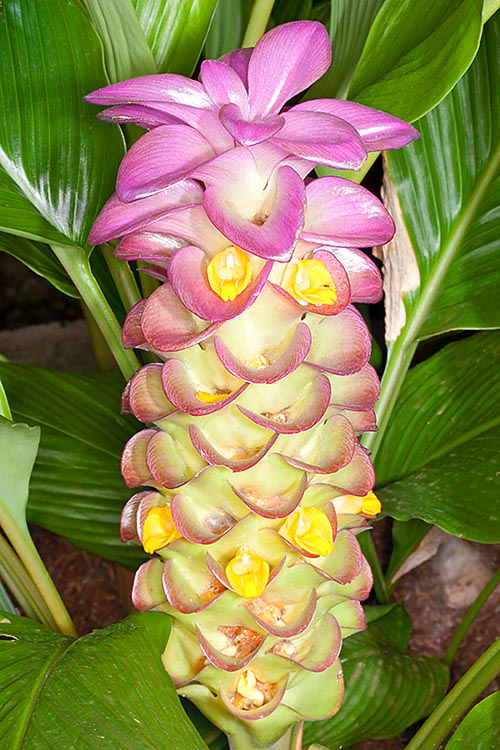Family : Zingiberaceae

Text © Pietro Puccio

English translation by Mario Beltramini

Curcuma aurantiaca is a South-East Asian rhizomatous perennial herbaceous species. Ornamental leaves and showy cylindrical 20 cm inflorescences © Giuseppe Mazza
The name of the genus comes from the Arabic “kurkum”= saffron, with reference to the saffron yellow colour of the rhizome of Curcuma longa L. (1753); the name of the species is the Latin adjective “aurantiacus, a, um” = of orange colour, with reference to the colour of the fruits.
Common names: rainbow curcuma (English); temu blobo, temu purot (Javanese); koneng kalamasu (Sundanese).
The Curcuma aurantiaca Zijp (1915) is a rhizomatous, perennial, herbaceous species, deciduous, erect, up to about 70 cm tall, with a small fleshy conical rhizome internally yellow. The leaves, on a 15-20 cm long petiole, are basal, simple, elliptic with pointed apex, 18-45 cm long and 8-25 cm broad, plicate, of intense glossy green colour. The inflorescences, on a 6-20 cm long peduncle, quite variable for shape and colour of the bracts, are terminal, cylindrical, 10-20 cm long and of 8-12 cm of diameter, formed by roundish bracts with curved apex of greenish yellow, pink, purple or brown colour, 3 cm long and 2,5 cm broad, enclosing the flowers with trilobed tubular corolla, 4,5-5,5 cm long, of orange yellow colour, orange labellum about 2 cm long and staminodes of the same colour. The upper bracts without flowers, 4 cm long and 3,5 cm broad, have variable colour, from greenish white to green, pink, brown or purple, and form a sort of tuft at the apex of the inflorescence. The fruits are obovoid capsules, 1,5 cm long and of 1 cm of diameter containing obovoid seeds provided of white aril.
It reproduces by seed, in loam rich of humus with addition of sand or perlite per a 30%, maintained humid and in shady position, at the temperature of 22-26 °C, but usually and easily by division during the resting period.
Amongst the most ornamental of the genus, due to the foliage and the coloured inflorescences, it is cultivable in the humid tropical and subtropical climate zones; at level of rhizome it can stand temperatures around the 0 °C only if maintained perfectly dry. Requires a semi-shaded position and soil rich of organic substance, perfectly draining maintained humid. Out of the tropical and subtropical zones the rhizomes can be interred in spring, at 5-10 cm of depth, with blooming by late summer, and conserved in autumn, during the resting period, in dry location at a temperature preferably over the 10 °C. During the vegetative period the waterings must be regular and abundant, but without stagnations, and the fertilizations done with balanced products with microelements.
The young inflorescences are locally consumed as vegetable. Thanks to their long duration, 2 and more weeks, and the bright colours, the cut inflorescences are very much appreciated in the floral compositions.
Synonyms: Curcuma ecalcarata Sivar. & Balach. (1983).
